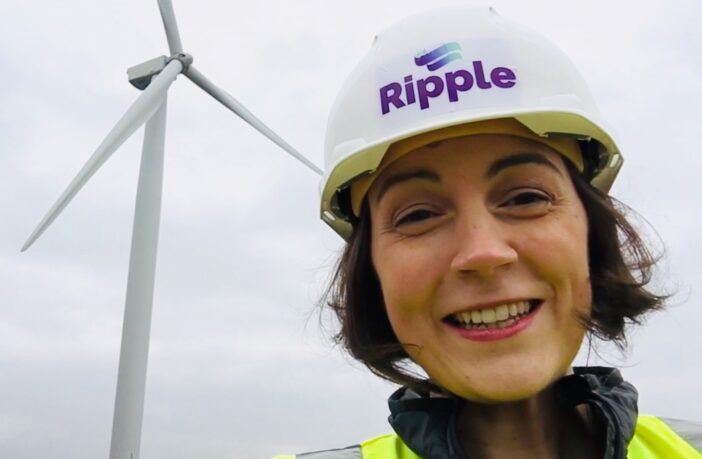From the moment we heard about Ripple Energy and its innovative plans to enable homes and businesses to part-own large-scale wind and solar farms we were intrigued. Here is a business that is harnessing renewable energy in a new way, which also the potential to deliver significant savings to its customers.
And it isn’t just the Transition Earth team that has been impressed by London-based startup either. In February the company won the Elevator accelerator competition for startups, an event hosted by communications agency, Eulogy.
Then last month the company announced the launch of the first-ever consumer-owned wind farm which has been backed by a £1m of funding. The farm is owned by 675 households who have already signed up to the platform and who have collectively raised over £1.3m. It will go live by autumn 2021.
So now seemed the perfect time to catch up with Sarah Merrick, CEO and Founder of Ripple Energy to find out what was the catalyst that led to the creation of Ripple, how the company intends to scale and what the potential is for wind power in the UK
So what was the inspiration for Ripple – was there a Eureka moment?
I’d worked in the wind energy industry for over 20 years before starting up Ripple. The Eureka moment was when I worked out how little it would cost for an individual household to own enough of a wind farm to supply their electricity and how much cheaper it was compared to rooftop solar. It was literally on a bit of scrap paper.
The energy industry is ripe for disruption as UK consumers are used to having a select few suppliers and options when choosing energy sources for their homes. Ripple was established to challenge this and truly put consumers’ energy into their own hands, allowing them to part-own a wind farm to power their homes with authentic and affordable clean energy.
And what do you see are the key issues that you are trying to solve?
Firstly, Ripple enables people to act on climate change by creating the clean energy future they are desperate to see.
Secondly, Ripple enables its members to make long term savings on their electricity bill. Wind is the UK’s cheapest source of electricity, so owning a bit of a wind farm leads to real savings.
Finally, the energy industry is very traditional in the way that it operates and serves consumers. This is something Ripple is challenging. We strive to put the buying power, and the wider fight against climate change, into consumers’ own hands.
And how did you raise money initially? Were there any challenges in crowdfunding?
We initially raised money through crowdfunding. When I learnt that women who led start-ups secure less than two per cent of venture capital funding in the UK, it was a hammer blow. That’s why at Ripple, we’ve chosen the crowdfunding route, as it seems to be a lot more open to female founders. As a result, Ripple now has nearly 2,000 amazing investors.
How do you see wind power developing in the UK? Some days we have 50% of our energy from wind – how much can it grow?
Wind power has huge potential for the UK, given our natural climate, weather conditions and being an island. Wind currently supplies just over 20% of the UK’s electricity, that’s set to grow to 60% by 2030. Also the amount of electricity people use is set to increase as we switch to electric cars and electric heating. There’s huge scope for growth.
Instead of pension funds or big infrastructure funds owning our energy assets, Ripple wants to give people the opportunity to own them. After all, they’re needed to supply people with electricity. We want to open up ownership to people for the first time ever.
You recently announced your first wind farm in Wales. How will that be constructed and run? And how many wind farms do you hope to build this year?
Our first project has just received part funding from the Welsh Government so we have the green light to begin construction on our Graig Fatha wind farm in South Wales. We have the turbine on order and construction will begin this summer, with the first spade going into the ground in June – July time.
The wind farm will then be fully operational and all of our current members will begin to receive energy generated by the co-operative turbine later this year. There are still opportunities for new members to get involved and join the first project.
The project will be run and managed by Ripple, with members of the co-operative receiving their energy via suppliers Octopus and Co-Op Energy.
This year, we will be announcing plans for our second project. This will start building in the latter part of this year, to become fully operational in early 2023.
What would you say are the main motivations of your investors?
Ripple provides a new model for consumer energy generation and consumption, which is a landmark moment in the history of sustainable energy in the UK.
In addition, the market for green technology businesses is ripe ahead of COP26 and amidst the UK Government’s Build Back Greener campaign. The prospect of investing in a business that is contributing to this movement by generating renewable energy alternatives is really exciting.
How do you see Ripple growing in the coming months and years? Will you need to undertake further fundraising rounds?
Ripple plans to grow through larger scale projects, across multiple locations. We’re looking into solar parks too in addition to wind farms.
For our second project, we will be looking to get more investors on board to support the development. The project will also be larger than the Welsh one, allowing for more Ripple members to become part of the co-operative.




